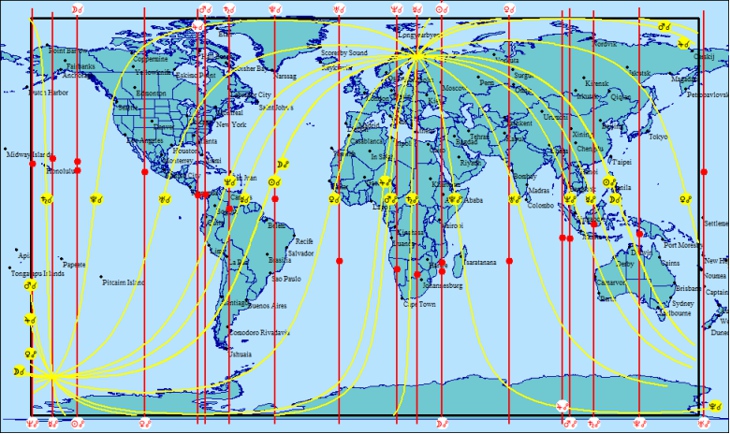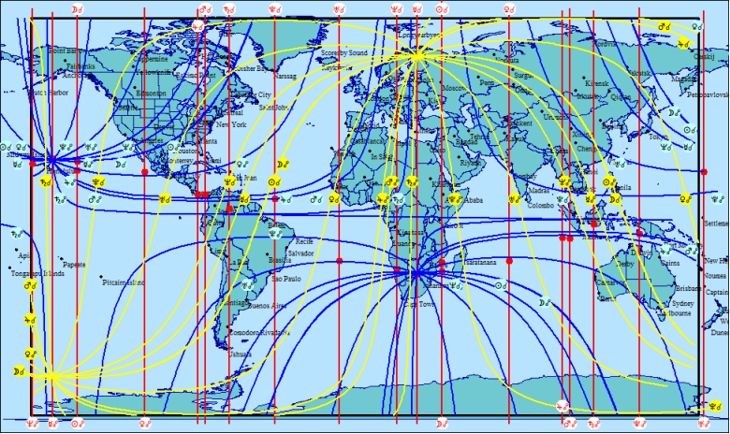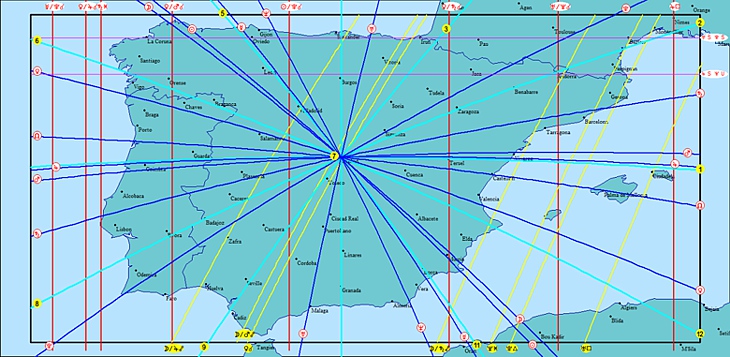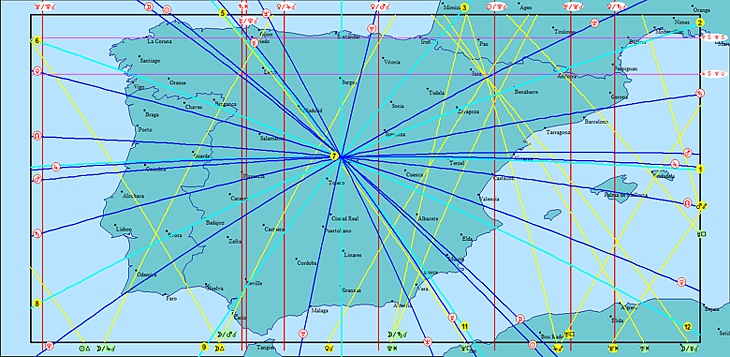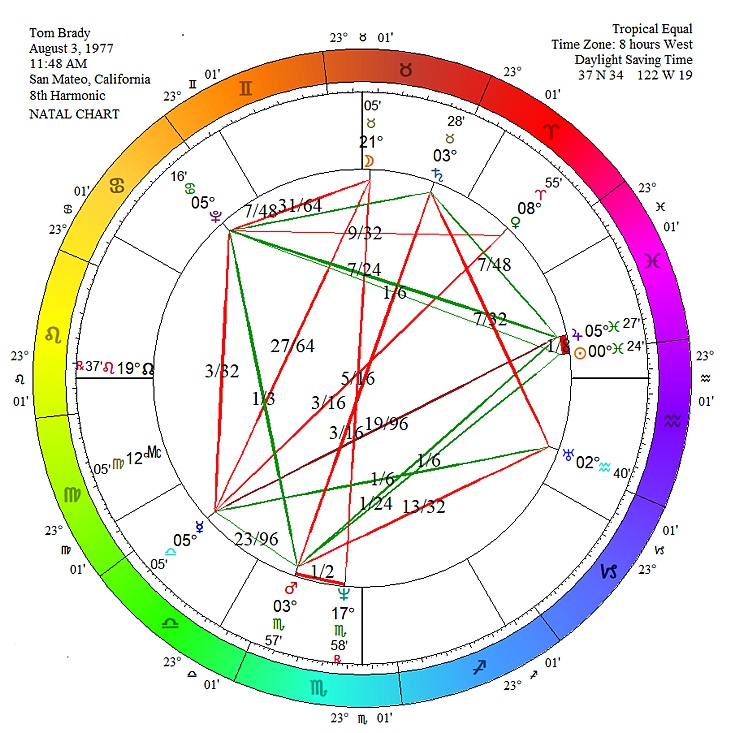 Windows 10 / 11 compatible!
Windows 10 / 11 compatible!
|
Sirius version 4 is now in English, Turkish, and Spanish language.
We are grateful to Öner Döşer’s team in Istanbul and to Ursula Stockder’s team in Mexico City for their help in editing the user interface in Turkish and Spanish. Also thank you to Cosmic Patterns Software team specially David and Vic for their hard work and dedication to making this project possible. THANK YOU!
Select a country flag to indicate that the language is English, Spanish, or Turkish. After selecting the language about 98% to 99% of the user interface (menus, buttons, etc.) will be in that language! You no longer need to be fluent in English to use the Sirius software. The English and Turkish language selections have been edited by native speakers in that language. Some of the Spanish language user interface has been edited by a native Spanish-speaking person, but not all of it yet.
New Medieval Natal Report by Öner Döşer in English and Turkish
The Medieval Natal Report can be used as a reference tool. You can refer to get ideas about the meaning of the house placements of rulers of houses, or as a report that you email or print for a client. Oner decided very generously to include this report in the Sirius software rather than make it an optional purchase to help educate the astrological community using this technique which he specializes. This report is written from the perspective of ancient western astrology so the traditional rulers and the medieval method of calculating the Part of Fortune is used. Thank you Öner!!! Click here to view a English sample report.
Improved, larger database of charts
Sirius 4.0 includes over 90,000 charts of famous people, countries, company charts, etc. The earlier version of Sirius, version 3.0, has over 60,000 charts. Also, a large number of birth times and accuracy ratings have been corrected. We are grateful to Alois Treindl and his team at www.astro.com for their generosity and assistance. Having a large database of charts included is tremendously convenient. If you wish to look at the chart of the Prime Minister or President of a country, or a well-known musician, artist, scientist or notable person for any other reason, there is a good chance that when you start entering their last name in the name field in the data entry screen, you will see their name. Click on it and in the notes field you will also see a link to the online AstroDatabank at www.astro.com. This ability to bring up the charts and click to confirm the data and obtain biographical information at www.astro.com is also in Sirius 3.0, and we are mentioning it here in case you are not familiar with these features and so you can appreciate some of the reasons why this huge database included with the software is very helpful.
Vedic Gemstone Analysis Interpretive Report by Jack Hauck
Click here to view a Gemstone Analysis Interpretive sample report.
Gemstone Calculator
The Gemstone Calculator gives Vedic astrology rules for wearing each of 7 gems based on the rising sign. The 7 gems are ruby, pearl, red coral, emerald, yellow topaz, diamond and blue sapphire. The rules given describe how to use the gem depending on the placement of a planet in a house, and you must refer to the Vedic astrology chart to see what the house placements are. This report is designed for astrologers and students of astrology who can refer to the birth chart. In using this report, you also get trained in ways to do a Vedic gem analysis as you apply the rules, and you can use these rules as long as you know very basic fundamentals of astrology in order to see how the rules based on your Ascendant apply to you. This report is available in English and Turkish. Click here to view a Gemstone Calculator sample report.
Vertex lines in “Just Lines” reports and Treasure Maps: A New AstroMap Feature
Most likely you are familiar with AstroMaps. The Ascendant and MC lines on an AstroMap show where a planet forms an aspect or a midpoint structure to the relocated Ascendant or MC. This new feature of AstroMaps allows you to also see Vertex lines on “Just Lines” Maps (standard AstroMaps) and Treasure Maps simply by checking a box to include them. The lines are color-coded: MC lines are red, Ascendant lines are yellow, and Vertex lines are blue. To understand why the ability to add Vertex lines is very important, consider this: there are places in the world, such Rovaniemi, Finland, where it is not possible to know precisely where the Ascendant is because the Ascendant sometimes moves about 1 degree per second of time! In order to calculate the Ascendant accurately to a minute of arc you would need to know the birth time with about 1/60 of a second. When the Ascendant is moving about 1 degree per second of time, that is equivalent to about 60 degrees in 1 minute of time. Below is a simple AstroMap that shows conjunctions and opposition lines only to the Ascendant and MC is shown below for our hypothetical client born on January 2, 1980 at 10:32 AM in Madrid, Spain:
Where all of the lines meet in the northern part of Europe is just north of Rovaniemi where our hypothetical client moved. If this point was truly exceptional, we could visit it to experience some kind of state of singularity or oneness with all because all lines converge at this point. Everyone has this point somewhere along the arctic circle and another one opposite to it on the Antarctic circle. However, I do not recommend making this journey because the power of the Ascendant fades away and most likely you will not experience anything unusual at these locations. Below is the same AstroMap with Vertex lines included. The Vertex lines are the blue lines:

David Cochrane is giving a lecture about this feature and calculation at the Vibrational Astrology Conference 2023. Click here for more details about this conference: Vibrational Astrology Conference 2023 / Schedule
Combine Local Space, Paran, Planet Lines and Midpoint Lines in One AstroMap: A New AstroMap Feature:
In Sirius 4 it is possible to place aspect lines, midpoint lines, paran lines and Local Space lines in one AstroMap. Here is an example of this AstroMap for a person born in Madrid, Spain and the AstroMap is done for Spain:
This AstroMap can be produced in In Mundo or in Zodiac longitude. The AstroMap above is in Zodiac Longitude. The one below is In Mundo.
Asteroids can also be included in these AstroMaps. There are several kinds of AstroMaps in the Sirius software. One of them is the “Flexible AstroMap”. In Sirius 4.0 the Flexible AstroMap has a check box to select paran lines and a button to select whether you want Local Space lines or a variation of Local Space Lines known as Horizon Lines.
Arabic Parts used in Ottoman Empire astrology can be selected
The list of arabic parts that you can select has been increased from 408 to 517. These are additional arabic parts used in the astrology of the Ottoman Empire and were contributed by Turkish astrologer Öner Döşer. This is convenient for astrologers who use these arabic parts as they do not need to be manually entered. When selecting a list of Arabic Parts a new selection "Short List by Öner Döşer" is convenient for astrologers who use the Arabic Parts used in consultations by Öner Döşer.
Vibrational Astrology Forecast
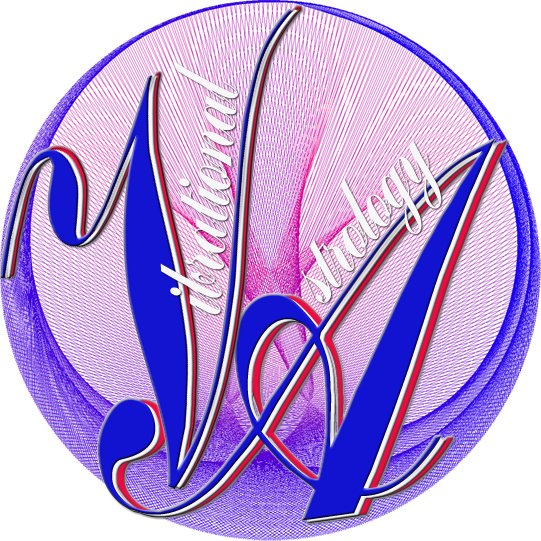
Introducing the Vibrational Astrology Forecast!!! You can now obtain a listing of when a transiting planet combines with 2 natal planets in a harmonic, or when 2 transiting planets combine with a natal planet in a harmonic. You can select the duration that the aspect is within orb and what the maximum allowable orb is. The window for selecting the Vibrational Astrology Forecast is shown below. Near the bottom of the window are the selections for maximum orb and minimum number of days that the aspect is within orb. A small orb shows only planetary patterns that are very strong. Specifying a longer time period shows only planetary patterns that are in effect for a longer duration of time. Below is an example of the Vibrational Astrology listing for tennis player Serena Williams for the 3 days September 7 – 9, 2018. It uses the setting of a maximum orb of 5 degrees and a minimum time period of 10 days. This produces a short list of planetary configurations that are in effect for a relatively long time.
This listing shows us that transiting Uranus and Pluto were in 7-Vibration aspects with Serena’s 7-Vibration Uranus and all 3 planets were within a 4 degree orb. Also, transiting Pluto was in 54-Vibration aspect with natal Mars and Neptune and all 3 planets were within a 2 degree orb.
New “4-Hour” Forecast AstroSignatures
There are 13 new “4-Hour” forecast AstroSignatures. They are called the “4-Hour” forecasts because we recommend that you set the frequency of calculations to 4 hours for these forecasts. The frequency of calculations is a setting for all AstroSignature forecasts. These new AstroSignature forecasts analyze aspects that may be within orb for less than half a day so fluctuations throughout the day are detected. The feature to show times adjusted to any location enables you to see how these changes occur throughout the day for the clock time at any location. 4-Hour Detail: Drive & Motivation (Hard aspects), For these AstroSignatures you can select either “Transit-to-Natal” to see planetary configurations formed by either one transiting planet and two natal planets or by two transiting planets and one natal planet, or you can select “Transit-to-Transit” for planetary patterns formed by the transiting planets to each other. Here is an example of a forecast for 7 days with 7 of the 4-Hour AstroSignatures selected:
These 4-Hour forecasts include nearly every 3-planet configuration and transit-to-natal midpoint structure related to the vibration, and there are typically dozens of these configurations at any given time. On an anecdotal level, the forecast shows promise of being useful. For example, the above forecast was done for David Cochrane and on December 2 David decided to post on social media a link to a youtube video, and he decided that he may post a video every day because there are over 600 videos and a new one could be posted every day for nearly 2 years, and this use of social media for “shameless promotion” as the saying goes of one’s own work might grate against some people as it can appear self-absorbed. That this happens as the “Seeking Superiority” line graph makes a conspicuous peak and the most conspicuous peak of the month. David looked at the graph after making the decision so the graph did not influence his thoughts.
New and Beautiful Designer Wheels: 160 of Them!
Added to a huge list of wheel styles already within the program. Earlier versions of the Sirius software came with 30 Art Wheels. These are artistically rendered wheel. In Sirius 4 we added 160 more of these wheels, and these wheels are the highly praised Designer Wheels developed by Matrix Software. We decided to include the complete Designer Wheel collection in the Sirius software with no additional charge. This full set of Designer Wheels sells for $100 as an option to our Matrix line of software. These wheels are beautiful. Below are some sample chart wheels from this Designer Wheel collection that is included in Sirius 4.0.
New Wheel Style and New Wheel Style Settings
A new wheel style designed by Turkish astrologer Öner Döşer has been added, and several new features that can be selected for any single wheel style (note that some of these features do not work in BiWheels, TriWheels, and QuadWheels). Some of these new features are:
Detailed Jones Chart Types with Explanation
The Jones 7 Chart Types are a popular way to determine the overall quality of a birth chart. The 7 types that the distinguished astrologer Marc Edmund Jones identified are the Bundle, Bowl, Locomotive, Seesaw, Splay, Splash and Fan. For example, a chart in which the planets are spread around about 120 degrees is a called a Bowl type, and if the planets spread around about 180 degrees it is a Bowl Type. A Seesaw chart type has two groups of planets roughly opposite to each other. Of course, almost no chart is a perfect Bundle, a perfect Bowl, or a perfect representation of any of the 7 Jones chart types. You might, for example, have a Bowl chart but there is a large gap of 45 degrees or 60 degrees, so it like a Bowl with a hole in it, as opposed to a Bowl chart type that has the planets very evenly distributed across almost exactly 180 degrees. In order to account for these variations, the Detailed Jones Chart Types feature that is new in Sirius 4.0 has 45 different chart types. A few examples of these chart types are the Bundle, Wide Bundle, the Wide Bundle with Seesaw Qualities. The Bowl, the Bowl with Bucket Qualities, the Wide Bowl, and the Wide Bowl with Bucket Qualities. By detecting all of these variations of the Jones Chart Type, we are able to identify very clearly how a specific chart varies from the pure original 7 Chart Types that Jones identified. Without the help of a computer, it would be tedious to check all of these variations, but some astrologers who are very experienced in using the Jones Chart Types, do notice the way a particular chart varies from a pure Jones Type chart, and the incorporate this into the interpretation. The Detailed Jones Type feature added to Sirius 4.0 is helpful for identifying and interpreting these deviations for a pure Jones Type chart.
Harmonic Highlights Report in Spanish and Turkish
The Harmonic Highlights Report is now available in Spanish & Turkish. In earlier versions of Sirius the Harmonic Highlights Report was only in English but now it is in Spanish & English and you simply select the desired language. Again, thanks to our Cosmic Patterns team in Mexico City for providing the Spanish translation, and our team in Istanbul Turkey for translating it ins Turkish.
The English Harmonic Highlights Report is Improved. A Vibrational Astrology report.
The English Harmonic Highlights Report has been improved to include midpoint structures between planets Jupiter through Pluto. For example, if Jupiter is at the Uranus/Neptune midpoint or Saturn is at the Jupiter/Pluto midpoint this was not interpreted in earlier versions of the Harmonic Highlights Report because at least one planet had to be Sun, Moon, Mercury, Venus or Mars for the midpoint structure to be interpreted. In Sirius 4.0 these midpoint structures are also interpreted. This version is not on the Spanish version.
The Cosmo Natal Report in Spanish has been improved to now include aspects between Neptune and Pluto
Some interpretive reports are improved over time, and gradually the reports get improved in all languages. Adding aspects between Neptune and Pluto to the Spanish Cosmo Natal Report is an example of one of these minor improvements.
Strongest Compatibility Vibrations
A very exciting new Vibrational Astrology feature!!! This feature identifies what wavelength two people are on. All harmonics up to 360 are analyzed to determine in which harmonics there is the strongest synastry. The strongest synastry is determined by seeing in which harmonics there are the most aspects and midpoint structures and with the smallest orbs. A very helpful feature of this report is that the details of what is occurring in every vibrational chart is also provided so you know exactly what planetary configurations are contributing to the strength of the vibration.
Improvements to Vedic Listing
The Vedic Chakras section of the Sirius software is where the heart of many of the Vedic astrology features are. There are some improvements to the listings on the right side. For example, the nakshatra and pada of Lagna, Rahu and Ketu were missing and they have been added.
Improvements to the Appearance of the Text Ephemeris and Other Kepler Workshop features
Some fonts have been made larger and some tables made more attractive. Improvements to the appearance on very high resolution monitors were also made. Options for displaying planets to greater accuracy and other options were added that some astrologers requested.
Nakshatra Report
The Nakshatra Report interpretation is now included to the Sirius program. The 12 zodiac signs are very familiar to most of us, and many people know their Sun Sign. In India a different system of celestial signs has also been used. It is a system of 27 signs and each sign has a length of 13 degrees and 20 minutes, rather than 12 signs of 30 degrees each. These 27 signs are known as "nakshatras". Nakshatras are widely used by Indian astrologers to provide vitally important information. For example, nakshatras are used for determining compatibility in marriage and the naming of children. The nakshatra image combines with the descriptive information to provide you a window into the deep wisdom of ancient India. This report is designed to shed light on your individual nature and soul's purpose.
Talisman Images
Select from Art Gallery or from the Electional Graph and then select “Classical Electional: Planets” The resulting 28 talisman images convey the power and strength of the original descriptions given in the Picatrix! the Picatrix is an ancient book which describes 4 different images for each of the 7 traditional planets. Note that we refer to the Sun and Moon as planets, but obviously they are not planets. Each column of pictures shown below is the image of a different planet; the first column is the Sun, followed by the Moon, Mercury, Venus, Mars, Jupiter, and Saturn. Each of the 4 rows of images is the 4 different images in described in the Picatrix for a planet.
Avalon Lessons in Norwegian
Anders Krovel from Norway who is one of our Authors and licensed dealer in Norway translated the Avalon Lesson in Norwegian. Thank you, Anders!!!
Avalon Lessons in Turkish
The Avalon Lessons is now available in Turkish.
Norwegian Cosmo Forecast Now has Outer Planet Transit Interpretations
The Norwegian Cosmo Forecast Report now includes outer planet transit interpretations. The English version of the Cosmo Forecast Report originally included only inner planet transits and the Norwegian version of this report was translated before outer planet transits were added to the English report. Now the Norwegian version of the Cosmo Natal Report is updated to include outer planet transits as well.
Flexible Search: Ability to select AstroDatabank categories in Data Entry Screen
The online AstroDatabank available at AstroDatabank.com has a very extensive categorization of charts, which allows a person to be categorized many ways. For example, an actor who is an alcoholic is classified as both an actor and an alcoholic. You can now access charts that are in the AstroDatabank using the AstroDatabank categories. This provides the ability to find all people who have a particular trait regardless of what they are best known for. This is a tremendous help for researchers and people who love to explore people with similar traits. This feature is accessed by clicking the “Flexible Search” button in the data entry screen, and then clicking the “Select ADB Categ.” Button. Then you can select the AstroDatabank category desired and you can also select an accuracy rating. This feature combined with the other Flexible Search features to search the Notes field, to limit charts to be from a particular year, search the first name, etc. gives many ways to find the data that you are interested in.
Ability to Search for the Name of the Star in the Star Catalog
Instead of scrolling down the list of stars in the Star Catalog, you can enter the name of the star to find it. This is one of many improvements to make the software more convenient.
Detailed Isotrap Analysis is added to Harmonic Patterns Listing #1
Isotraps are symmetrical 4-planet combinations. They are also known as “planetary pictures” and they can also be viewed as being a planetary configuration in which a midpoint is conjunct or opposition another midpoint. For example, if the Sun/Moon midpoint is opposition the Jupiter/Saturn midpoint, then this is an Isotrap. An interesting property of Isotraps is that there are two pairs of planets that have nearly the same angular distance. Some astrologers view this as a kind of double resonance. Although Isotraps sound like a new concept, an Arabic Part forms an Isotrap with the the 3 planets in the Arabic Part so it is an idea with an ancient heritage as well. An Isotrap in which these same angular distances are also aspects is particularly powerful. For example,the Detailed Isotrap Analysis for the 8-Vibration chart of American football quarterback Tom Brady is shown below. The first Isotrap shown in this lies is Sun/Mer cnj Mar/Ura with an orb of 0 deg 34 min.
We see in Tom Brady’s 8-Vibration chart below that The Sun is trine Mars, and also Mercury is trine Uranus. Sun, Mer, Mar and Ura form an Isotrap configuration. In an Isotrap configuration there is a midpoint conjunct or opposition another midpoint, and in this case it is Sun/Mer midpoint conjunct Mar/Ura midpoint with a 34’ orb. What is less obvious than the trine aspects is that there is also a Mer 1/13 Mar and a Sun 1/13 Ura aspect. In the 13-Vibration chart of this 8 vibration, which in other words is the 104 (13x8) Vibration chart we will find that one of these pairs of planets is conjunct with no orb and the other is conjunct with a 15 degree orb.
Super Symmetry Midpoint Analysis is added to Harmonic Patterns Listing #1 – SUPER SYMMETRY MIDPOINT PATTERNS
The Super Symmetry Midpoint Analysis shows midpoint structures in any vibrational chart from 1 to 360 that share 2 planets in common. For example, the Super Symmetry Midpoint Analysis for Tom Brady’s 8-Vibration chart is shown below.
In Tom Brady’s 8-Vibration chart there is a Mar opp Sun/Plu midpoint and a Mar opp Jup/Plu midpoint. These two midpoint structures have the planets Mar and Plu in common. You will notice that in the list shown above there are two planets in common in each midpoint structure. When two planets are shared by two midpoint structures, we call it a Super Symmetry planetary configuration because midpoint structures are symmetry patterns and there are multiple symmetries created by the planets. When there is a large Super Symmetry pattern the total number of points for that vibration is high. For Tom Brady’s 8-Vibration chart the total score is 5 points, which is more than most other vibrations. Like the Detailed Isotrap Analysis, select Listings and then Harmonic Patterns Listings and then listing #1. Scroll down and you will see the Super Symmetry Midpoint Analysis below the Detailed Isotrap Analysis.
MIDPOINTS TO MIDPOINTS TO ASCENDANT AND DESCENDANT
Midpoint-to-midpoint conjunctions and oppositions now include planetary configurations that include the Ascendant or Descendant. In earlier versions of Sirius the midpoint-to-midpoint listing included only the 10 main planets.
MIDPOINTS TO MIDPOINTS TO MC & IC
Similar to the midpoint-to-midpoint listing that includes the Ascendant and Descendant described above, there is also now a listing that includes the MC and IC in the midpoint-to-midpoint listing.
Synastry / Aspects Listing of planets in this chart to arabic parts in another chart
The Arabic Parts Synastry Listing shows planets in one chart conjunct an Arabic Part in another chart. Select Synastry and then select the menu item for the listing of planets in one chart to the Arabic parts in the other chart.
|
|||||||||||||||||||||||||||||||||||||||||||||||||||||||||||||||||||||||||||||||||||||||||||


